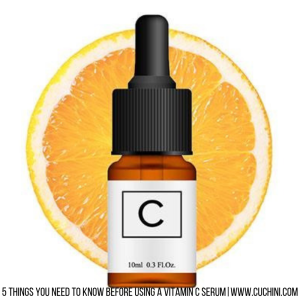 Vitamin C has tons of skin benefits. This powerful antioxidant helps even out skin tone, protects us from sun damage, and increases our skin’s turnover rate, among others. These are backed by years of dermatology research, too, so it’s no wonder it’s one of the most popular serum ingredients out there. Adding it to our skincare routine could solve concerns like hyperpigmentation, signs of aging, and rough skin, provided that you know how to work it to your advantage. Because as much as we love vitamin C, we can’t deny that it’s one finnicky ingredient. Below, we list five things you need to know before (or while) jumping on the C-serum train:
Vitamin C has tons of skin benefits. This powerful antioxidant helps even out skin tone, protects us from sun damage, and increases our skin’s turnover rate, among others. These are backed by years of dermatology research, too, so it’s no wonder it’s one of the most popular serum ingredients out there. Adding it to our skincare routine could solve concerns like hyperpigmentation, signs of aging, and rough skin, provided that you know how to work it to your advantage. Because as much as we love vitamin C, we can’t deny that it’s one finnicky ingredient. Below, we list five things you need to know before (or while) jumping on the C-serum train:
1. How to Store It
Vitamin C serums have a relatively short shelf life because the more it’s exposed to heat, light, and air, the less potent it becomes. Eventually, the serum will oxidize and lose all potency, and you’ll know when this happens when the liquid darkens to a brassy brown.
However, you can delay the oxidation process by storing the bottle as far away from light and heat as possible, like inside the refrigerator. Avoid leaving it near a window or anywhere exposed to direct sunlight! Letting your serum live its best reclusive life should help preserve its potency for longer, but note that it won’t prevent oxidation from happening altogether. Once your serum oxidizes, it’s officially time to toss it, unless you want your skin to be stained orange, that is.
2. The Packaging
Since this antioxidant-rich serum is sensitive to light, the way it’s packaged plays another important role to keeping it fresh and effective. Products stored in dark, opaque bottles block out more light than those in clear bottles, hence being more efficient for preserving stability. Air-tight containers, such as those with pumps, prevent overexposure to air that also reduces the stability of vitamin C.
However, if your serum is a thinner liquid, it’ll most likely come with a dropper that’ll inevitably expose the active ingredient to air more often and make it oxidize faster. So instead of wasting a ton of product, try purchasing for smaller quantities that you can finish before the three-month mark.
3. How to Shop for It
When browsing the shelves for serums, there are two other things you should check: the kind of vitamin C used in the product and how much of it the product actually contains.
Vitamin C comes in different forms, hence it could be listed with various names in the ingredients list. The most popular from these is ascorbic acid (or L-ascorbic acid), mostly because of the volume of research that backs up its skin benefits. Other forms of the antioxidant include ascorbyl palmitate, ascorbyl glucoside, and magnesium ascorbyl phosphate.

If you’re new to this ingredient, how much vitamin C in your serum is crucial for avoiding irritation. Start with as low as 5% ascorbic acid if you’re just starting out, and then slowly work your way up. Or, you can try a potent serums with 15 to 20% ascorbic acid for faster results, but remember to incorporate it into your routine slowly (using it only once/twice a week in the beginning).
4. How to Use It
Incorporating vitamin C into your regimen can’t be any simpler. It’s just like your regular serum, but perhaps a little bit better. When it comes to where it fits in your skincare routine, it ideally should be applied after cleanser and toner but before moisturizer. You can choose to use it once or twice a day, depending on your skin’s needs and tolerance.
If used in the morning, a dose of vitamin C helps shield your skin from free radicals, protecting you from further sun damage. If applied at night, on the other hand, it would have less products to compete with (makeup, sunscreen, etc.) and can aid skin repair even more. Either way, the ingredient will be there to provide your skin with the antioxidants it craves, so feel free to choose what works for you. But for the record: You can definitely apply it morning and night if your skin can handle it! However, do remember to apply sunscreen in the day for extra protection!
5. Ingredients you shouldn’t mix it with
As much as our skin loves vitamin C, combining it with certain ingredients could wreak actual havoc on your skin. So for the sake of preventing overexfoliation and irritation, avoid combining vitamin C with exfoliating ingredients such as retinol, salicylic acid, and glycolic acid. That said, you can use them separately on different times of the day depending on your skin’s capacity. For example, applying vitamin C in the day and then retinol at night is much gentler than using them both at once.
 Did you enjoy this article?
Did you enjoy this article?






